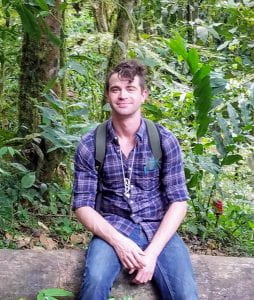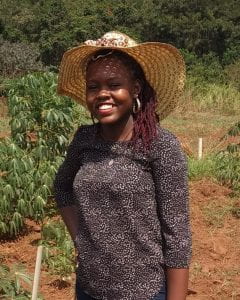Plant disease detection, trait characterization in malting barley, and soil organic matter – these are a few of the diverse graduate student projects recently funded through the Schmittau-Novak Small Grants Program. Supported by a bequest from the estate of Jean Schmittau in honor of Joseph Novak, Plant Biology Professor Emeritus, the Schmittau-Novak Small Grants Program is designed to provide graduate students in the School of Integrative Plant Science with the opportunity to experience the process of writing and reviewing proposals, and implementing a research plan of their own design. Nine proposals were selected for Spring 2021 funding. The program is directed by Dan Buckley and Teresa Pawlowska.
Developing Tissue Culture and Transformation in Non-Model Monocots: Leveraging Biodiversity to Investigate Floral Fusion

Heather Phillips is a third year PhD candidate in the Specht lab, where her research utilizes the tropical monocot order Zingiberales in order to study the evolution and development of unique floral fusion phenotypes, including the labellum in the ginger group and the fused petal-sepal tube in the banana group.
Abstract: Within the tropical monocot order Zingiberales two major patterns of floral form can be observed, including the presence of a large, fused labellum (i.e. fused petaloid stamens) in the ginger clade and a fused floral tube composed of petals and sepals in the banana group. C. spicatus and M. basjoo serve as excellent representatives of the ginger and banana groups, respectively, and display numerous traits unique to each of these groups, including these distinct fusion phenotypes. Research into floral development of Arabidopsis and Petunia indicates that transcription factors belonging to the NO APICAL MERISTEM/CUP SHAPED COTYLEDON3 (NAM/CUC3) subfamily are responsible for regulating the development of fused structures by establishing boundaries between developing organ primordia.
While loss of function nam/cuc3 mutants present with increased fusion between floral organs, mutants in species that have naturally occurring fused floral organs (i.e. Petunia hybrida) present with the opposite phenotype, namely a loss of fusion in floral organs which normally develop as fused. Thus, the role of NAM/CUC3 transcription factors is proposed to be twofold: i) preventing fusion between unfused floral organs, and ii) being co-opted to promote, rather than prevent, fusion in flowers which develop fused organs.
This project aims to design targeted knockouts of candidate NAM/CUC3 genes in Costus and Musa which should confirm whether these genes show a conserved function in SAM maintenance, and furthermore have been co-opted for the development and evolution of fused structures in this order.
Using hyperspectral spectroscopy for early detection of citrus greening and assessing disease associated physiochemical alterations
 Saeed Hosseinzadeh is a 3rd year PPPMB PhD candidate in Michelle Heck’s lab. His research focuses on bridging molecular ‘omics and spectranomics to develop an in-field early detection method for citrus greening disease. He spends his free time working with a non-profit to empower disadvantaged kids in Iran. He also enjoys camping and mountain biking.
Saeed Hosseinzadeh is a 3rd year PPPMB PhD candidate in Michelle Heck’s lab. His research focuses on bridging molecular ‘omics and spectranomics to develop an in-field early detection method for citrus greening disease. He spends his free time working with a non-profit to empower disadvantaged kids in Iran. He also enjoys camping and mountain biking.
Abstract: Citrus greening or Huanglongbing (HLB), is considered the most serious disease of citrus and is caused by a phloem-limited bacterium, “Candidatus Liberibacter asiaticus” (CLas). HLB is quickly spreading throughout the citrus growing US states despite strong efforts to quarantine it. However, quarantining does not account for the key fact that symptoms of HLB may take 6-12 months to develop after the initial inoculation event, and during that asymptomatic time trees may act as sources of inoculum. Hyperspectral spectroscopic techniques have the potential to distinguish CLas-infected citrus plants from healthy, non-infected plants at the early, asymptomatic stage. In this project, paired reflectance hyperspectroscopy and multi-omics datasets will be used to determine how early spectral reflectance data can detect asymptomatic HLB disease, and to correlate hyperspectral reflectance wavelength features to specific CLas-related physiochemical changes. This correlation will be used to develop a model that can be applied to early detection of diseases in-field with high accuracy.
The characterization of malting barley germination traits and their relationship to malting quality over time to inform breeding for pre-harvest sprouting resistance and malting quality
 Travis Rooney is a PhD student in the Field of Plant Breeding, co-advised by Mark Sorrells and Edward Buckler. His research is focused in two areas, the first is breeding better malting barley for New York, and the second, nutrient cycling within maize production with a focus on increasing sustainability.
Travis Rooney is a PhD student in the Field of Plant Breeding, co-advised by Mark Sorrells and Edward Buckler. His research is focused in two areas, the first is breeding better malting barley for New York, and the second, nutrient cycling within maize production with a focus on increasing sustainability.
Abstract: High malting quality barleys (Hordeum Vulgare L.) are often susceptible to pre-harvest sprouting (PHS) damage as they lack grain dormancy due to selection for early, rapid, and uniform germination post-harvest to facilitate malting. Demand for locally grown malting barley in non-traditional production regions and climate change are spurring interest in PHS resistant barleys with good malting quality. PHS resistance is mediated by dormancy, however a high degree of dormancy leads to barley that will not readily germinate during malting. The demand for PHS resistance by growers must be met while balancing the needs of the malthouse for grain that can be easily malted. By examining malting quality changes during after-ripening in conjunction with easily measurable germination traits we seek to identify a means to optimize the combination of PHS resistance and malting quality in the development of new malting barley varieties, determine their genetic correlations, and develop a more cost effective method for breeding programs to screen large panels of breeding lines for malting quality before expensive formal malting quality is undertaken.
Identifying drivers of diversity and ecologically functional traits in the hypervariable butterfly mariposa lily, Calochortus venustus (Liliaceae)
 Adriana Hernandez is a Ph.D. Candidate in Chelsea Specht’s lab in the Plant Biology Section of the School of Integrative Plant Science. As an integrative evolutionary biologist, she investigates fundamental principles at the intersection of population genetics, evolutionary history, landscape, and ecology.
Adriana Hernandez is a Ph.D. Candidate in Chelsea Specht’s lab in the Plant Biology Section of the School of Integrative Plant Science. As an integrative evolutionary biologist, she investigates fundamental principles at the intersection of population genetics, evolutionary history, landscape, and ecology.
Abstract: Adriana is leveraging a California endemic lily, Calochortus venustus, that exhibits highly polymorphic floral forms and variation in the degree of polymorphism across populations to identify mechanisms of adaptive diversification at subpopulation and metapopulation scales. The Schmittau-Novak 2021 award will be used to identify the ecological mechanisms and functional traits that maintain striking phenotypic diversity and to establish a baseline of ecological data for this hypervariable species. Adriana will test across hypotheses of pollinator preference and constancy, floral phenology, fitness (seed set), and a heterogeneous landscape of physical environmental variables such as soil pH, that could underlie floral diversity and drive local adaptation. Adriana will be working with Nicholas Rocha, a sophomore undergraduate student in Entomology and Plant Science at Cornell, as he strengthens his pollinator identification skills and learns how to track pollinator behavior (constancy). Nick will be a co-author on this paper and will present preliminary findings in the form of a poster at the Botany 2021 conference.
Genetic control of aquatic crassulacean acid metabolism in Isoetes engelmannii, an enigmatic lycophyte
 David Wickell is a PhD student studying the evolution of seed-are plants in Fay-Wei Li’s lab. His current research is focused on Isoetes, an enigmatic group of aquatic lycophytes also known as quillworts. In addition to working with other members of the Li lab to publish the first Isoetes genome assembly, he is interested in using quillworts as a window into processes including polyploidy, hybridization and the convergent evolution of crassulacean acid metabolism in aquatic plants.
David Wickell is a PhD student studying the evolution of seed-are plants in Fay-Wei Li’s lab. His current research is focused on Isoetes, an enigmatic group of aquatic lycophytes also known as quillworts. In addition to working with other members of the Li lab to publish the first Isoetes genome assembly, he is interested in using quillworts as a window into processes including polyploidy, hybridization and the convergent evolution of crassulacean acid metabolism in aquatic plants.
Abstract: Isoetes is a diverse group of largely aquatic lycophytes. It is a member of one of the earliest diverging lineages of vascular plants with a fossil record extending back to the Carboniferous period. Isoetes is particularly interesting due to its ability to fix carbon via crassulacean acid metabolism (CAM) while submerged. This is in stark contrast to the traditional view of CAM as an adaptation to prevent water loss in plants growing in arid environments. In fact, CAM has evolved independently multiple times in every major lineage of vascular plants. In Isoetes, CAM is an adaptation to limited CO2 in the waters they inhabit, allowing them to sequester carbon at night when CO2 levels are highest. Many species of Isoetes are “facultative” CAM plants, capable of switching from C3 metabolism when emergent to CAM when submerged. Expression of both CAM and C3 pathways in a single organism provides a powerful tool for researchers to characterize molecular pathways that drive nocturnal acid accumulation. This project will utilize RNAseq to explore differential expression of CAM related genes in the facultative CAM species Isoetes engelmannii. Manipulation of environmental conditions and molecular characterization of expression patterns over time will provide a detailed description of the genetic mechanisms controlling the shift between C3 and CAM in this aquatic species. This will stand as a necessary counterpoint to similar studies in terrestrial plants. In addition, as the earliest diverging lineage of vascular plants to acquire CAM, this represents an important step toward understanding the forces that have driven the convergent evolution of this complex trait across vascular plants.
Does Molecular Diversity of Soil Organic Matter Depend on Plant Inputs or Microbial Community?
 Rachelle LaCroix is a PhD Candidate, advised by Dr. Johannes Lehmann, in the Soil and Crop Sciences section. Her research is broadly focused on investigating how molecular diversity of soil organic matter influences soil organic carbon persistence.
Rachelle LaCroix is a PhD Candidate, advised by Dr. Johannes Lehmann, in the Soil and Crop Sciences section. Her research is broadly focused on investigating how molecular diversity of soil organic matter influences soil organic carbon persistence.
Abstract: The vast stocks of organic carbon (C) in soil are to a large extent a product of microbial activity and at the same time vulnerable to microbial degradation—resulting in the release of two potent greenhouse gases, methane, carbon dioxide and indirectly nitrous oxide. The relative balance of C stored in the atmosphere, or as soil organic matter (SOM), has a direct influence on the effects of climate change experienced globally. An emerging mechanism of soil organic carbon persistence is the molecular diversity of SOM. SOM molecular diversity is likely controlled by microbial-driven decomposition processes of plant inputs. A large portion of the plant biomass first goes through the microbial “funnel”. The microbial “funnel” likely contributes to molecular diversity through transformation of plant-derived litter and the release of a wide suite of exoenzymes, metabolites, extracellular polysaccharide substances and lysed microbial cellular bodies. What is not clear, is if the molecular diversity of the resulting DOM pools is dependent on litter type, ecosystem conditions, or soil microbial community composition. Furthermore, how molecular diversity impacts the mineralization rates of SOM is unclear. My project hypotheses are that (1) greater plant-derived molecular diversity of DOM diminishes mineralization rates, and (2) microbial driven transformations of DOM result in similar molecular diversity profiles over time, regardless of plant litter inputs. I plan to use soil samples from vastly different ecosystems across the US to determine if litter type or microbial community affects molecular diversity of SOM, and thus its ability to persist in the soil.
Increasing soil organic carbon and plant phosphorus uptake using polyphosphate accumulating organisms and arbuscular mycorrhizal fungi
 Yejin Son is PhD student working in the lab of Dr. Jenny Kao-Kniffin in Horticulture. I was raised in South Korea and majored in Horticultural Biotechnology during BSc studies. I studied an MSc course in sustainable agriculture at Newcastle University and received a Fulbright Scholarship for my PhD at Cornell.
Yejin Son is PhD student working in the lab of Dr. Jenny Kao-Kniffin in Horticulture. I was raised in South Korea and majored in Horticultural Biotechnology during BSc studies. I studied an MSc course in sustainable agriculture at Newcastle University and received a Fulbright Scholarship for my PhD at Cornell.
Abstract: My research for the SNIPS grant will look at the interaction between arbuscular mycorrhizal fungi (AMF) and polyphosphate accumulating organisms (PAOs) for soil carbon and phosphorus cycling in the rhizosphere of corn. AMF are known to be effective in increasing carbon accumulation in soils and enhancing soil microbial activities for phosphorus uptake by plants. By contrast, little is known about the agricultural roles of PAOs because they are mostly used in wastewater recycling technology due to their high capacity to retrieve phosphorus from wastewater. As both microorganisms are closely related to phosphorus cycling, my curiosity has led me to the present research work addressing interactions between AMF and PAOs for soil phosphorus uptake by corn. Also, I hope to determine whether PAOs can increase plant growth and AMF development, which would allow more plant-derived carbons to return to soils, enriching the soil carbon pools. The research will involve multiple state-of-the-art techniques, including quantitative PCR, Raman spectroscopy, Raman single-cell sorting, flow cytometry, metagenomics, and proteomics, to see which species of PAO are abundant in the soil of corn and how AMF and PAO treatments impact soil carbon and phosphorus pools as well as soil microbial communities and protein expressions. The benefits of this research will be the discovery of a novel interaction of soil microbes that facilitates soil carbon and phosphorus cycling which is essential for successful plant growth. This can provide novel biological solutions such as low-cost microbial amendments that can enhance crop productivity and promote agricultural sustainability.
Comprehensive characterization of cassava brown streak virus isolates for targeted resistance breeding in Uganda

 Leah Nandudu is Ph.D. student, advised by Dr. Jean-Luc Jannink in the field of plant breeding and genetics. Her research is focused on identifying and characterizing the genetic mechanisms of cassava brown streak viruses which are the causal agents for cassava brown streak disease (CBSD) using low-cost high-throughput phenotyping methods.
Leah Nandudu is Ph.D. student, advised by Dr. Jean-Luc Jannink in the field of plant breeding and genetics. Her research is focused on identifying and characterizing the genetic mechanisms of cassava brown streak viruses which are the causal agents for cassava brown streak disease (CBSD) using low-cost high-throughput phenotyping methods.
Stephanie Preising is a Ph.D. student advised by Dr. Michelle Heck in the section of Plant Pathology and Plant-Microbe Biology. Stephanie’s research focus is on bridging the gap between basic and applied virology using molecular techniques and computational biology. She currently researches blocking the transmission of potato and cotton viral pathogens.
Abstract: Cassava (Manihot esculenta Crantz) is a mainstay for both the rural and urban populace in the developing world. In sub-Saharan Africa, cassava takes on the imperative role of being a major staple as it flourishes in marginal soils and drought environments with little agricultural inputs. Despite this resilience, production potential has never been attained largely due to viral diseases. Cassava brown streak disease (CBSD) is now the most devastating viral disease that causes 70-100% yield loss in susceptible varieties thus affecting food and economic security for millions in East and Central Africa. Breeding for resistance continues to be one of the most practical and sustainable options for CBSD control, but it has also been challenging. This challenge is largely due to the complexity of cassava brown streak viruses that arise due to the genetic diversity of isolates. Currently, the Ugandan cassava breeding program has no information on the diversity of CBSD isolates which further antagonizes the CBSD resistance breeding progress. The goal of this study is to identify, characterize and update whole-genome sequences of CBSD viral isolates by deep sequencing virus-derived short interfering RNAs (siRNAs). This will entail reforming the current sampling strategy and incorporating extensive sampling from farmer fields. The findings from our research will ensure that cassava varieties are rigorously tested to ascertain their resistance durability under situations of mixed and diverse isolates, which is a commonplace in farmers’ fields.
Shotgun metagenomic analysis of the epiphytic apple microbiome following controlled atmosphere storage, fungicide use, and biocontrol application
 Connor Lane is a 1st year PhD student in Cornell’s Horticulture program studying microbial ecology in conjunction with postharvest crop management. They are additionally interested in computational genomics and science writing and communication.
Connor Lane is a 1st year PhD student in Cornell’s Horticulture program studying microbial ecology in conjunction with postharvest crop management. They are additionally interested in computational genomics and science writing and communication.
Abstract: Plant microbiomes affect many agriculturally important traits such as disease resistance, and knowledge from more robustly studied plant rhizosphere communities may inform dynamics and methods used to study the microbiome’s role in postharvest storage. Apples (Malus domestica) are an ideal crop for studying postharvest microbiomes due to their long storage times. Here, we will employ a technology called shotgun metagenomics to sequence large regions of bacterial and fungal genomes, which provides more information about functional aspects of microbial genomes than amplicon barcoding procedures. This technology has proven possible even for apple microbiomes, but has not been used in full experiments with different treatments due to cost and difficulty in preventing against host contamination. In this study, we will test the microbiome response to low O2 and high CO2 storage (controlled atmosphere) commonly used in apples, as well as fungicides and biocontrol using Bacillus subtilis, across a 9-month storage period. We will tie the genomic data we gather back to functional microbiome traits, such as detecting toxin genes.
